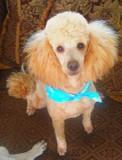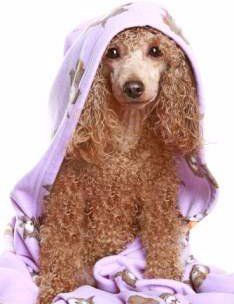Apricot Poodles
Apricots are one of the most beautiful Poodle colors
and one of the most sought after. Their coats are a sunny, gleaming hue, producing quite a gorgeous color.
An apricot Poodle may have some deviation in their color, such as a vaguely darker feathering on their ears and/or tipping on their ruff. This variation is not considered a fault under the AKC breed standards.

Jasmine
Photo courtesy of Brianna

A light apricot, next to a deeper, darker red
Photo courtesy of Floyd Ferdinand Gelacio
Apricots most often have black points which mean the noses, eye-rims and lips, black-or self-colored toenails and very dark eyes. They may, nevertheless, have dark amber eyes, liver nose leather, eye-rims and lips. This, too, is permissible, but not the ideal coloration. This is true for reds as well.
The apricot gene is a recessive to all the poodle colors except white.
It is not uncommon for an apricot to be dubbed a red or vice-versa. Additionally sometimes a cream will be called an apricot if it is deep. As a Poodle matures, color may lighten or deepen a bit and for this reason, a pup that appeared to be a light apricot may darken into a more solid medium cream or other similar toning that shows the wrong color was chosen at the time the pup was registered. Since a breeder can register a Poodle to be any color, not all owners of apricot Poodles will have that color designation on their dog's papers. Alternatively, there are owners of red or cream Poodles that have papers showing that the dog is apricot. These types of things do happen with breeds that come in such a wide range of not only colors, but variations and tones of those colors.
Apricot is one of the last poodle color to be recorded. Some say that is it indeed the very last one; others say that red sprang from apricot, making it simply one of the last.
It is suspected that apricot is a very rare occurring combination of brown , blue and perhaps white in different concentrations, which then produce the different shades that we see with apricot Poodles.
All other colors of the Poodle were established before the apricot came into play.
The very first apricot, Sowden Yellow Gall, born in 1898 was actually dubbed a liver by its owner who had browns, therefore it is estimated that the color was perhaps a bit different than the one we know of today. This same owner produced a litter of 8, 6 were reds and 2 were brown…
The sire was liver and the dam a brown. This amazing litter was sold to an English kennel which then worked to continue the apricots and reds, thus allowing us to have apricot Poodles today.
At the time, they were working only with Standards.

In the year 1912, Miniatures
were starting to pick up in popularity with pet owners, so in turn breeders responded to that. It was during this time that a unique and beautiful Poodle puppy was born in the Whippendell Kennel, she has a gorgeous apricot coat and to the surprise of many, her brother was a solid black.
In 1929, there was the first apricot champion, Phigidity Jessie who happened to have a black sire and a blue dam. Higidity Jessie was a Standard.
In the 1930’s some exceptionally dedicated breeders in the United States began to improve the Poodle lines with the help of dog imported from England.
Descendants of the English apricots, carrying the genes are the dogs that are responsible for all of the apricot Poodles that we have today.
The first American champion was Champion Carillon Amour, in 1935. In the 1940's poodle breeding slowed down quite a bit due to WWII, however in the 1950's two important apricot kennels worked in England to produce excellent apricot Poodles...
In regard to the toy size class, they were the Greatcoat lines and in regard to the Miniature size variety, they were the Puckshill lines.

